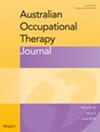Occupational therapy-led environmental assessment and modification—A quantitative evaluation of a pilot implementation study in a regional/rural setting
Abstract
Introduction
Environmental assessment and modification is an effective fall prevention intervention for high-risk older people, which has not yet been adopted in routine occupational therapy practice.
Methods
A pilot pre-post quantitative implementation study was carried out in a regional hospital and health service, within a community-based occupational therapy service, in Queensland between 2019 and 2022, involving 279 occupational therapy medical chart audits of people aged ≥65 at high risk of falls, clinical practice observations of 9 participating occupational therapists, and 32 staff questionnaires.
Consumer and Community Involvement
Occupational therapists were included as co-researchers, but there was no health consumer or community involvement in the study.
Results
Baseline fall rates were higher than anticipated, with 71% of clients sustaining ≥1 fall in the year preceding intervention and 52% sustaining ≥2 falls. Sixty per cent of people with ≥3 of the 5 identified fall risk factors died during the study period. Implementation outcomes included penetration, fidelity, acceptability, and sustainability.
Penetration
A fall prevention environmental assessment was provided when indicated in 80% of cases during and immediately after implementation. This increased to 97% 2 years after implementation.
Fidelity
When intervention was indicated, the occupational therapists delivered a high-intensity fall prevention environmental intervention, as per protocol, in 100% of cases.
Acceptability
Staff surveys revealed a marginal, non-statistically significant, increase in staff knowledge, attitude, confidence, and experience in fall prevention between the baseline and follow-up periods.
Sustainability
Medical chart audits revealed that implementation was sustained for 30 months and beyond post implementation.
Conclusion
This project demonstrated that environmental assessment and modification was delivered per protocol, embedded in clinical practice, and sustained after implementation. Occupational therapists' precision, in determining who should receive the intervention, increased over time. The results of this pilot will inform the design of a national implementation study, which commenced in 2025.
PLAIN LANGUAGE SUMMARY
Checking an older person's home for fall risks can help lower their chances of falling by about 38%, especially if they are more likely to fall. People may be at higher risk because of how they do certain tasks, the tasks themselves, hazards in the environment, health issues, or a mix of these things. An occupational therapist does the assessment by watching the older person do daily tasks, like getting dressed or doing chores. This helps to find out what might cause a fall. The therapist then talks with the person about which activities they feel are most risky, asks for their ideas on how to stay safe, and helps them to make a plan. The therapist also checks in later to help put the plan into action. In this study, we trained therapists to do this kind of fall check. We looked at whether occupational therapists followed the training, if the right people were offered the assessment, and if it was still used after the project ended. We found that therapists did the assessments as they were trained to and with the people who needed them most. The therapists also kept doing the assessments after the project was over. This likely helped reduce falls.


 求助内容:
求助内容: 应助结果提醒方式:
应助结果提醒方式:


